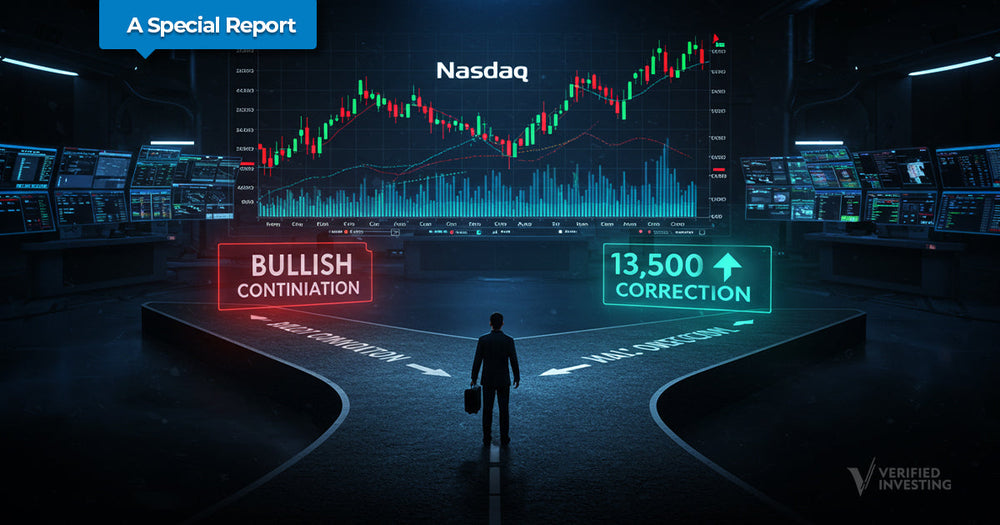A Special Report: The Nasdaq’s Fragile Path

A Special Report: The Nasdaq’s Fragile Path
Exploring Gareth Soloway’s Call for a 33% Correction and the Lessons of Past Market Cycles
Introduction: An Ominous Signal in Quiet Charts
It all began with a single, striking tweet from Gareth Soloway, the Chief Market Strategist at Verified Investing. He posted a chart, highlighting a “rising parallel channel” on the Nasdaq’s daily timeframe, suggesting the index could soon drop toward 13,500—a pullback that, if realized, would place the market nearly 33% off its all-time highs. In a financial landscape often saturated by hype and short-term noise, such a bold statement ignited a flurry of speculation among investors, many of whom had grown used to the Nasdaq’s relentless climbs over the past decade.
But is this simply another bearish siren call destined to fade, or does Gareth’s chart hold deeper truths about shifting market psychology, macro forces, and the cyclical nature of bull and bear phases?
This special report takes a narrative approach to unravel the context and implications of Gareth’s analysis. We’ll explore the meaning behind a “rising parallel channel,” revisit moments in Nasdaq history when similar cautionary signals predated significant downturns, and peek into the psychological challenges that arise when unstoppable rallies suddenly meet the threat of correction. Above all, we’ll stress that an informed perspective—grounded in both data and historical awareness—can help traders navigate uncertain times with confidence and composure.
1. The Tweet That Sparked Concern
“NASDAQ in a rising parallel channel. Potential drop to 13,500 or so if this breaks. That’s about 33% off the highs.”
Even stripped of nuance, Gareth Soloway’s succinct tweet carried a heavy punch. In the swirl of social media, many took it as a final clarion call: “Bearish times are back!” Others dismissed it as standard “doom talk” from someone presumably short the market. The truth, as is often the case, sits somewhere in between: no credible technical analyst aims to spread blind fear, and no thorough chartist would discount the possibility of proven historical patterns.
This appears to be playing out perfectly. If history is correct, the Nasdaq is eventually headed to 13,500, a 33% drop from the all-time highs.https://t.co/wfOqM2zMqB
— Gareth Soloway (@GarethSoloway) March 15, 2025
Here’s what the heart of that tweet implies:
- A Rising Parallel Channel: This is a chart pattern formed by two upward-sloping trendlines. The lower trendline supports price dips, the upper line caps rallies. Markets can ascend within this neat “lane” for months—even years—until external forces or internal exhaustion prompts a break below that lower boundary. Once that break materializes, price often tumbles to re-test deeper support levels.
- 13,500 as a Target: The 13,500 level, from a chart standpoint, might align with long-term support zones or past pivot areas. If the Nasdaq is near a record high north of 20,000 (just as an approximate for the sake of argument) or even in the mid-19,000 range, then a drop to 13,500 constitutes a 30%+ decline—hardly trivial for an index dominated by technology stocks.
- Technical Probability vs. Certainty: Soloway’s tweet is less a prophecy than it is a reflection of probabilities. Technical analysis doesn’t “guarantee” anything, but it can outline key lines in the sand: if the lower boundary fails, here’s where the market might land next.
2. Why the Nasdaq’s Mood Matters
The Nasdaq Composite stands as a barometer of technology-driven exuberance. Over the last decade-plus, technology stocks have soared on narratives of disruptive innovation, ballooning valuations, and near-constant capital inflows. A correction in the Nasdaq often reverberates beyond Silicon Valley, rattling everything from consumer confidence to retirement portfolios.
Key reasons the Nasdaq is pivotal:
- Tech Stocks’ Market Weight: Giants such as Apple, Microsoft, Amazon, and other tech behemoths collectively carry massive influence. When they correct sharply, it’s akin to a giant stumbling in a crowded room—everyone feels the tremors.
- Investor Sentiment Indicator: Technology is the “shiny object” sector. A surge in these stocks often signals risk appetite, while a correction can herald a broader shift to risk-off positioning across all major indices.
- Innovation Proxy: The Nasdaq houses many growth-oriented companies pegged as “the future.” If their shares slide, it prompts deeper questions: Are valuations too high? Is the economic horizon dimming? Are interest rate or inflationary pressures stifling growth?
A potential 33% drop in the Nasdaq is not just a numeric milestone—it’s a reflection that markets might be adjusting their lens on risk, valuations, and future earnings potential. Hence, paying attention to these signals is less about day-to-day price movements and more about capturing the broader transformation in how investors weigh the big picture.
3. The Mechanics of a Rising Parallel Channel
Before diving further into the whys and hows of a potential drop, let’s dissect the chart structure Gareth referenced: the rising parallel channel.
3.1 Anatomy of a Channel
A parallel channel is formed by two trendlines that “contain” price action. In a bullish version:
- Lower Support Line (Trendline): Connects a series of higher lows. Each time the Nasdaq dips, it touches this line and bounces. This suggests underlying buying interest at these levels.
- Upper Resistance Line: Connects higher highs. Each major push upward meets a consistent angled ceiling, indicating profit-taking or short selling at these peaks.
Price oscillates between these boundaries, somewhat predictably, until the pattern resolves—often by a decisive break.
3.2 The Break that Matters
Technical analysis suggests that a channel break is significant because it signals a shift in the established equilibrium. If the Nasdaq drifts below that supportive lower boundary and confirms (by closing beneath it and failing to recapture it in subsequent sessions), the path of least resistance typically points downward.
In Gareth’s scenario, that downward path aims for roughly 13,500—a level presumably chosen because it aligns with historical pivot lows or major Fibonacci retracement points from a prior rally. The math that yields a “33% off highs” outcome underscores just how lofty the market had been.

4. Parallel Channels in History: Clues from Past Nasdaq Glories
Historically, markets have formed rising channels at multiple junctures—some culminating in mild corrections, others preluding major bear markets.
-
Late 1990s (Dot-Com Era)
- The Nasdaq soared on speculation about the “new internet economy.”
- Over the span of a few years, it formed multiple ascending channels that each resolved with sharper dips. Eventually, these dips coalesced into the cataclysmic bursting of the dot-com bubble.
- Not every channel break in 1997–1999 spelled disaster, but repeated breaks eventually eroded investor confidence, culminating in a crash that saw the Nasdaq tumble 78%.
-
2006–2007 (Pre-Financial Crisis)
- Another bull run took shape, albeit less tech-centric than the dot-com rally. Real estate and financial stocks soared, and the Nasdaq recovered strongly from early-2000s lows.
- Ascending channels on the daily and weekly timeframes broke down in late 2007, foreshadowing the global meltdown triggered by the subprime crisis.
- The index fell around 55% from its peak over the ensuing year and a half.
-
2019–2020 (Pre-Pandemic & Pandemic Crash)
- A robust channel guided the Nasdaq into 2020, until COVID-19 fear hammered global markets.
- The index lost about 30% in a matter of weeks but then violently reversed in one of the fastest recoveries on record.
- The channel break signaled panic—yet the environment was so extraordinary that near-infinite stimulus propelled a staggering rebound.
In each era, breaks below well-defined channels highlighted growing vulnerabilities, even if the severity of the subsequent drop varied. The lesson: a channel break rarely stands alone; it intersects with broader macro or sector-specific triggers (like ballooning valuations, interest rate shifts, or unexpected black swan events).
5. Macroeconomic Undercurrents and the Nasdaq
Though Gareth’s tweet is primarily technical, markets don’t move in a vacuum. A confluence of factors often amplifies (or softens) the impact of chart breakdowns.
- Monetary Policy & Rates: When interest rates are low, speculative sectors (tech, biotech) flourish on cheap capital. Rising rates can invert that dynamic, pressuring growth stocks as future cash flows are discounted more heavily, making current valuations appear lofty.
- Inflation & Consumer Spending: Persistent inflation can sap consumer spending power and corporate margins. Tech firms that rely on discretionary income may see revenue slow, triggering stock declines.
- Regulatory Environment: Tech giants face antitrust scrutiny or new data-privacy laws. Such headlines can weigh on sentiment, reinforcing negative technical signals if channels break.
- Global Trade & Geopolitics: Tensions in major tech-supply regions can hamper production or distribution. If the supply chain stalls, even a bullish channel can falter as earnings forecasts fall short.
If 13,500 becomes a reality, it may be because one or more of these factors has “punctured” the market’s exuberance. The synergy between a technical breakdown and a real-world event often drives large-scale corrections.
6. Investor Psychology: From Complacency to Alarm
A hallmark of bull markets is the psychological shift from skepticism to complacency. Traders who missed out on earlier gains jump in late, suspecting that “this time it’s different.” If a major chart support line like Gareth’s channel base cracks, the crowd can abruptly pivot from indifference to panic:
- Margin Calls: Investors heavily margined on big tech names discover that small dips can escalate margin pressures. Forced selling accelerates declines, fueling the breakdown.
- Stop-Loss Cascades: Many traders set mechanical stops near major technical levels. A break triggers these orders in a domino effect, intensifying downward movement.
- Sentiment Reversal: Bullish news no longer lifts prices the way it did, indicating a “sea-change” in how participants view risk.
This psychological dimension underscores why a channel breakdown might move beyond a simple 5% or 10% correction, heading into deeper territory.
7. The Role of Education and Observational Patience
In a world saturated with hot takes and ephemeral headlines, Gareth’s approach stands out for its emphasis on disciplined, fact-based charting. Whether or not the Nasdaq plunges to 13,500, the learning point is the same: staying informed and maintaining robust risk management helps you respond rationally instead of emotionally.
Practical tips for the everyday investor or trader:
- Chart Familiarity: Understand the basics of trendlines and channels. If you notice multiple touches along an upward-sloping support line, you’ll better gauge when a potential breakdown might loom.
- Long-Term Mindset: Even if a drop to 13,500 seems alarming, historically the Nasdaq has weathered bigger downturns and eventually recovered. For many long-term investors, corrections are part of the growth cycle—painful but also filled with bargains for those patient enough.
- Stay Engaged with Resources: Consistent observation of market commentary, such as the resources offered for free at Verified Investing, ensures you’re up to date on shifts in macro trends and chart signals. Education fosters agility in unpredictable waters.
- Diversify: If the Nasdaq corrects sharply, other asset classes might hold up better. Diversification remains a powerful shield against sector-specific declines.

8. How a Live Trading Room Could React
Even though we won’t dwell on direct advertisements, it’s worth highlighting how a real-time community environment—like Verified Investing’s live day trading room—might process a potential channel break:
- Collective Scanning: A break in the Nasdaq might correspond to breakdowns in major tech names. Verified Pro Traders could collaboratively identify which stocks are leading or lagging, gleaning clues for intraday plays.
- Educational Commentary: A well-run trading room seizes such pivotal moments to illustrate the importance of chart patterns, stop placement, and emotional discipline.
- Avoiding Hype: The best communities emphasize probabilities, not certainties. They remind participants that even if a downward move triggers, bounces or whipsaws can occur. The focus is on methodical risk control, not sensational calls for a meltdown.
9. Revisiting Past Market Peaks: Are We Repeating History?
For some, a 33% drop conjures nightmares of 2000–2002 or 2007–2009. Are we repeating those crash cycles, or is the modern market different? Consider these parallels and divergences:
- Similarity: Surging valuations driven by exuberant sentiment. The top-tier stocks hold huge weight in the indices, so if they correct, the entire index corrects steeply.
- Difference: Many present-day tech companies are profitable, with robust cash flows, unlike many dot-com startups that had zero revenue. So a 33% drop might not be akin to a total meltdown, but more of a severe “re-rating” of valuations.
- Similarity: Rising interest rates (or the end of near-zero monetary policy) can spook high-growth stocks—akin to how the dot-com mania ended when capital tightened.
- Difference: Global markets are more interconnected. Central banks coordinate, and massive liquidity often fosters quick rebounds. The speed at which corrections might self-correct is arguably higher now.
Whether that helps or hurts the significance of Gareth’s tweet remains an open question. But awareness of these cyclical and structural factors can at least ground our perspective in something beyond raw fear or blind optimism.
10. Balancing the Narrative: More Than Just a Bearish Call
It’s tempting to read Gareth’s call for a potential 13,500 target and label it outright bearish. Yet savvy readers note that technical analysts typically present both sides of the coin:
- Upside Scenario: The channel lower boundary might hold, bounces may result, or broader catalysts (like an unexpectedly dovish Federal Reserve or a surprising leap in corporate earnings) could re-energize a rally.
- Downside Scenario: That boundary fails, emotional selling flares, and the index cascades to deeper support at or around 13,500.
- Long-Term Perspective: Even if the latter scenario materializes, the Nasdaq remains the hub of technological innovation. Over multi-year horizons, big declines can set the stage for the next era of growth.
Thus, the tweet that fueled so much speculation is less a doomsday prophecy than a straightforward heads-up that a breakdown might loom.
Conclusion: Charting the Future with Preparedness and Education
From the vantage point of Gareth Soloway and others who prioritize chart-based insights, a potential 33% drop in the Nasdaq isn’t about sensational gloom. It’s about recognizing when the structure of the market shifts from an orderly uptrend to a more precarious footing. A rising parallel channel can persist for a surprisingly long stretch, but all channels eventually resolve, and if support cracks, the slide may be swift.
What does this mean for the average investor or trader?
- Respect the Signals: Even if you’re a long-term holder, it doesn’t hurt to pay attention when multiple chart indicators suggest caution.
- Educate Yourself: Tools abound—webinars, free articles, live day trading rooms. Verified Investing itself offers a range of resources, helping you interpret each day’s market nuance instead of reacting to fear-laden headlines.
- Plan for Multiple Outcomes: Yes, 13,500 might be in the crosshairs, but the market doesn’t always read the script. Prudent risk management ensures you don’t overextend, nor do you panic if we do see a deeper correction.
- View Correction as Opportunity: In every major Nasdaq decline, from the dot-com bust to the COVID-19 plunge, new leadership emerges. Smart money positions itself to acquire undervalued equities or high-potential growth names on discount.
In essence, the moral of Gareth’s tweet—like so many warnings from seasoned chart watchers—is that markets are cyclical, and illusions of perpetual upward motion often give way to a well-deserved reality check. If that check materializes into a 13,500 horizon, it might feel bruising in the short run, but markets have proven time and again their capacity to recover and even surpass former highs.
Hence, while the narrative of a 33% drop can unsettle even hardened traders, those anchored in sound education and robust, chart-based strategy need not quake in fear. They can pivot, adapt, and remain open to the next major shift, whether the market chooses to roll over or climb another rung of the bull ladder. Because in the grand tapestry of financial history, each correction is but a passing thread—what endures is the capacity to learn, adapt, and ride the next wave when it arrives.
Trading involves substantial risk. All content is for educational purposes only and should not be considered financial advice or recommendations to buy or sell any asset. Read full terms of service.




